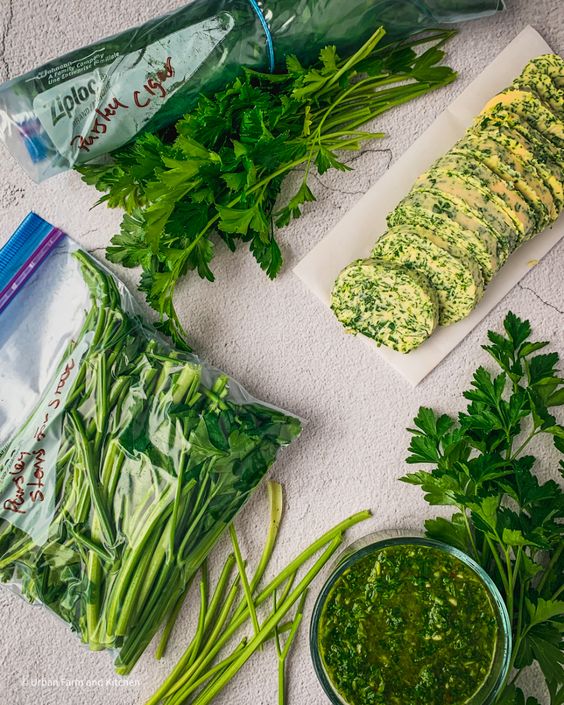Spices and aromatic herbs are your kitchen’s secret weapons, elevating the flavor of your dishes to new heights. Whether you’re infusing your sauces or crafting hearty broths, the inclusion of herbs like thyme, bay leaves, and parsley can make all the difference. However, to truly savor their rich flavors, it’s crucial to keep these herbs fresh. In this comprehensive guide, we’ll unveil the secrets to preserving parsley’s freshness for an impressive two-month duration.
Preserving Fresh Aromatic Plants: The Essentials
Ensuring the freshness of aromatic plants requires a touch of culinary finesse. If you find yourself uncertain about how to keep your parsley pristine, fret not. This article will provide you with expert insights into preserving parsley, ensuring it remains as fresh as the day it was harvested.
How to Keep Fresh Parsley in Stems?
The first step is to select vibrant green parsley with a crisp, invigorating scent. Steer clear of any wilted, brown, or shriveled specimens. Let’s explore various methods for preserving this aromatic gem:
1. Storing Parsley in an Airtight Container
- In a Glass Jar: Begin by finely chopping the parsley and storing it in a tightly sealed glass jar. This method is renowned for keeping parsley fresher compared to storing it as whole stems.
- Refrigeration Method:
- Gently wash the parsley to rid it of any dirt, dust, or unwelcome insects.
- Shake off excess moisture and finely chop the parsley, discarding the stems.
- Lay the finely chopped parsley on a plate inside the refrigerator.
- Stir the parsley daily to ensure uniform drying.
- Once it’s perfectly dried, safeguard it in an airtight container placed in a cool, dry location.
2. Storing Parsley in a Jar with Water
- Treat your fresh parsley like a vibrant bouquet of flowers.
- Trim approximately 12mm off the bottom of the stems and remove any discolored leaves.
- Only rinse the leaves when you’re ready to use them.
- Place the parsley stems in a jar filled with three-quarters water.
- Store this jar in the refrigerator with a loosely draped plastic bag secured by a rubber band.
- Remember to change the water every two days to maintain its freshness.
- Just before use, rinse the parsley and pat it dry with a paper towel or a salad spinner.
3. Using Paper Towels for Preservation
- Dampen a paper towel (preferably unprinted) and gently wrap it around the parsley.
- Seal it inside an airtight bag in the refrigerator. Re-moisten the paper towel if it dries out.
Preserving Chopped Parsley in the Freezer
For extended storage, your trusty freezer comes to the rescue. Here’s how to go about it:
- Pre-Freezing Preparation: Ensure your parsley is cleaned and thoroughly dried to avoid trapping any unwanted dirt or pests.
Using Oil for Preservation
- Option 1:
- Clean and dry your parsley.
- Finely chop it and place it in ice cube trays.
- Pour either olive oil or a neutral vegetable oil over the parsley, then freeze the cubes. These will become your secret weapons for flavoring soups and stews.
- Alternatively, put the chopped parsley in a freezer bag, add two tablespoons of vegetable oil, remove excess air, and seal.
- Option 2:
- Use a food processor to finely chop the parsley.
- Mix it with two tablespoons of olive or vegetable oil and freeze the mixture in ice cube trays. Once frozen, transfer the cubes to a freezer bag.
Storing Parsley in Water
- Clean and dry your parsley.
- Separate the leaves from the stems, place them in ice cube trays, cover with water, and freeze.
Blanching Parsley for Prolonged Preservation
- After rinsing, briefly blanch the parsley.
- As it begins to lighten in color, remove it and rinse it with cold water.
- Discard the stems, finely chop the parsley, and place it in ice cube trays with a bit of water. Freeze for 24 hours before transferring the cubes to a freezer bag.
In conclusion, adding the vibrant flavor of parsley to your dishes is a breeze with these preservation techniques. By choosing the right methods and freezing when necessary, you can enjoy the burst of freshness parsley provides whenever your culinary creations demand it.
Do you like this? Share inspiration with your friends!
